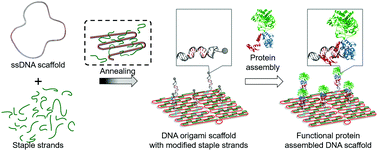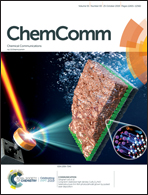Protein adaptors assemble functional proteins on DNA scaffolds
Abstract
DNA is an attractive molecular building block to construct nanoscale structures for a variety of applications. In addition to their structure and function, modification the DNA nanostructures by other molecules opens almost unlimited possibilities for producing functional DNA-based architectures. Among the molecules to functionalize DNA nanostructures, proteins are one of the most attractive candidates due to their vast functional variations. DNA nanostructures loaded with various types of proteins hold promise for applications in the life and material sciences. When loading proteins of interest on DNA nanostructures, the nanostructures by themselves act as scaffolds to specifically control the location and number of protein molecules. The methods to arrange proteins of interest on DNA scaffolds at high yields while retaining their activity are still the most demanding task in constructing usable protein-modified DNA nanostructures. Here, we provide an overview of the existing methods applied for assembling proteins of interest on DNA scaffolds. The assembling methods were categorized into two main classes, noncovalent and covalent conjugation, with both showing pros and cons. The recent advance of DNA-binding adaptor mediated assembly of proteins on the DNA scaffolds is highlighted and discussed in connection with the future perspectives of protein assembled DNA nanoarchitectures.



 Please wait while we load your content...
Please wait while we load your content...
